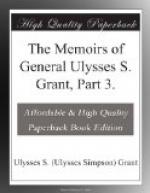It was necessary to have transportation for ammunition. Provisions could be taken from the country; but all the ammunition that can be carried on the person is soon exhausted when there is much fighting. I directed, therefore, immediately on landing that all the vehicles and draft animals, whether horses, mules, or oxen, in the vicinity should be collected and loaded to their capacity with ammunition. Quite a train was collected during the 30th, and a motley train it was. In it could be found fine carriages, loaded nearly to the top with boxes of cartridges that had been pitched in promiscuously, drawn by mules with plough, harness, straw collars, rope-lines, etc.; long-coupled wagons, with racks for carrying cotton bales, drawn by oxen, and everything that could be found in the way of transportation on a plantation, either for use or pleasure. The making out of provision returns was stopped for the time. No formalities were to retard our progress until a position was secured when the time could be spared to observe them.
It was at Port Gibson I first heard through a Southern paper of the complete success of Colonel Grierson, who was making a raid through central Mississippi. He had started from La Grange April 17th with three regiments of about 1,700 men. On the 21st he had detached Colonel Hatch with one regiment to destroy the railroad between Columbus and Macon and then return to La Grange. Hatch had a sharp fight with the enemy at Columbus and retreated along the railroad, destroying it at Okalona and Tupelo, and arriving in La Grange April 26. Grierson continued his movement with about 1,000 men, breaking the Vicksburg and Meridian railroad and the New Orleans and Jackson railroad, arriving at Baton Rouge May 2d. This raid was of great importance, for Grierson had attracted the attention of the enemy from the main movement against Vicksburg.
During the night of the 2d of May the bridge over the North Fork was repaired, and the troops commenced crossing at five the next morning. Before the leading brigade was over it was fired upon by the enemy from a commanding position; but they were soon driven off. It was evident that the enemy was covering a retreat from Grand Gulf to Vicksburg. Every commanding position from this (Grindstone) crossing to Hankinson’s ferry over the Big Black was occupied by the retreating foe to delay our progress. McPherson, however, reached Hankinson’s ferry before night, seized the ferry boat, and sent a detachment of his command across and several miles north on the road to Vicksburg. When the junction of the road going to Vicksburg with the road from Grand Gulf to Raymond and Jackson was reached, Logan with his division was turned to the left towards Grand Gulf. I went with him a short distance from this junction. McPherson had encountered the largest force yet met since the battle of Port Gibson and had a skirmish nearly approaching a battle; but the road Logan had taken enabled him to come up on the enemy’s right flank, and they soon gave way. McPherson was ordered to hold Hankinson’s ferry and the road back to Willow Springs with one division; McClernand, who was now in the rear, was to join in this as well as to guard the line back down the bayou. I did not want to take the chances of having an enemy lurking in our rear.




